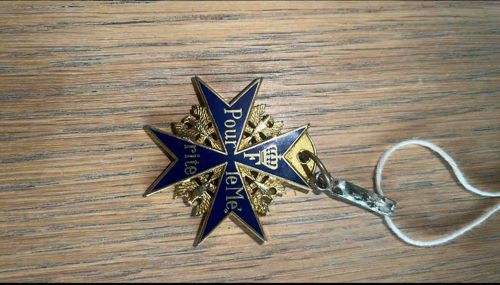
Pour le Mérite (Blue Max) Prussian Military Order
The item is a small, ornate cross often referred to as the Pour le Mérite, or 'Blue Max'. It features a distinctive maltese cross shape with four arms, and each arm is enameled in a deep, rich blue color with a thin gold border. Between the arms of the cross, there are intricate golden eagles, each with outstretched wings, adding to the decorative appeal. The central part of the cross displays gold lettering against the blue enamel, spelling out 'Pour le Mérite' – 'Pour' is visible on the upper arm, 'le Mé.' on the lower arm, and 'F' (possibly for Frederick or the initial of a relevant monarch) on the right arm, and 'rite' on the left arm. A prominent royal crown symbol is also visible on the arm of the cross to the right side of the center. The reverse side, though not fully visible, would typically show a similar design or an inscription. The medal appears to be constructed from gilded metal and blue enamel. The gold gilding shows some minor wear consistent with age and handling, particularly on the raised edges and the eagles, revealing slight dulling in certain areas, but no significant flaking or loss is apparent. The blue enamel appears largely intact with a glossy finish, although hairline cracks or minor chips, if present, are not clearly discernible from the provided image. The overall condition appears to be good vintage condition with appropriate patina. It is attached to a broken or cut piece of white cord by means of a small jump ring and a crimped metal finding, suggesting it may have been detached from its original ribbon or mounting system. Based on its historical context, this item likely dates from the 18th to the early 20th century, specifically associated with the Kingdom of Prussia and later the German Empire. Its craftsmanship, with detailed enameling and intricate metalwork, suggests a high-quality manufacture suitable for a prestigious military honor.
AI-Generated Appraisal Disclaimer
Estimated Value
$10,000 - $30,000
Basic Information
Category
Military Order/Decoration
Appraised On
November 28, 2025
Estimated Value
$10,000 - $30,000
Additional Details Provided By Owner
User Provided Information
The missing pour le merite that disappeared from Germany that is said to be owned by Noah Dohme that is the emperor of lixland which is 75 million square kilometers owned by Noah Dohme the emperor of lixland which is 18 years old the supreme general of lixland and the emperor of lixland
Item Description
The item is a small, ornate cross often referred to as the Pour le Mérite, or 'Blue Max'. It features a distinctive maltese cross shape with four arms, and each arm is enameled in a deep, rich blue color with a thin gold border. Between the arms of the cross, there are intricate golden eagles, each with outstretched wings, adding to the decorative appeal. The central part of the cross displays gold lettering against the blue enamel, spelling out 'Pour le Mérite' – 'Pour' is visible on the upper arm, 'le Mé.' on the lower arm, and 'F' (possibly for Frederick or the initial of a relevant monarch) on the right arm, and 'rite' on the left arm. A prominent royal crown symbol is also visible on the arm of the cross to the right side of the center. The reverse side, though not fully visible, would typically show a similar design or an inscription. The medal appears to be constructed from gilded metal and blue enamel. The gold gilding shows some minor wear consistent with age and handling, particularly on the raised edges and the eagles, revealing slight dulling in certain areas, but no significant flaking or loss is apparent. The blue enamel appears largely intact with a glossy finish, although hairline cracks or minor chips, if present, are not clearly discernible from the provided image. The overall condition appears to be good vintage condition with appropriate patina. It is attached to a broken or cut piece of white cord by means of a small jump ring and a crimped metal finding, suggesting it may have been detached from its original ribbon or mounting system. Based on its historical context, this item likely dates from the 18th to the early 20th century, specifically associated with the Kingdom of Prussia and later the German Empire. Its craftsmanship, with detailed enameling and intricate metalwork, suggests a high-quality manufacture suitable for a prestigious military honor.
Get Your Items Appraised
Instant estimates of your treasures with AI-powered instant appraisals